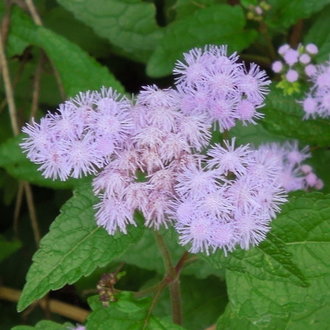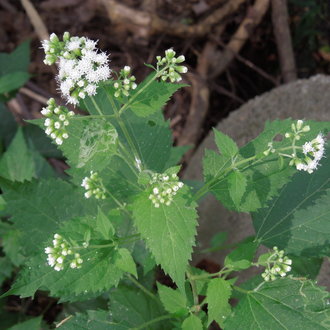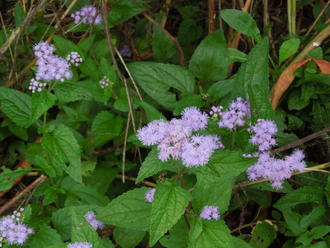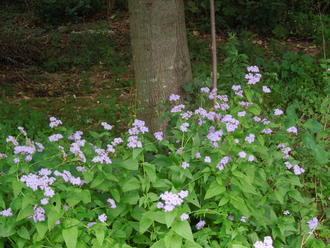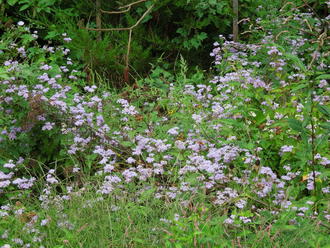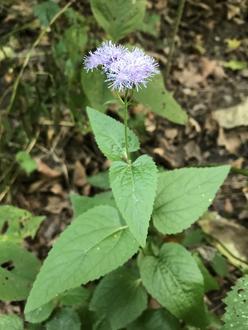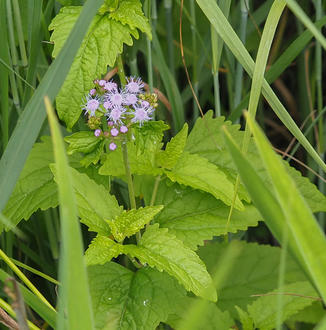Blue Mistflower (Conoclinium coelestinum (L.) DC.)
↑Summary
A low-growing rhizomatous perennial of moist, sunny areas, with blueish lavender flowers and opposite, triangular leaves.
↑Range - Expand
| Legend | Color |
| Native or Expanded | |
| Native | |
| Native or Not Present | |
| Native or Expanded or Not Present | |
| Expanded or Not Present |
This map is based on our research. We have checked its accuracy to Level 3 ecoregions. Although this plant occurs somewhere in each of these regions, it may only occur in a small part of some or all of them.
↑Similar Plants
↑Habitat
Prefers moist, often poorly-drained conditions in full sun to light shade. Found in moist meadows, openings in bottomland forests, seeps and ditches.
↑Life Cycle
Conoclinium coelestinum spreads aggressively by rhizomes when conditions are favorable, but is somewhat picky about conditions, requiring both sufficient sun and moisture. It can handle only light shade.
The plant produces wind-distributed seeds, but, relative to other plants of the Eupatorium tribe, it often focuses more effort on vegetative reproduction.
This species is not drought tolerant and a sufficiently long dry period can kill an entire vegetative colony, but plants will often resprout from seed, recolonizing the area, if favorable conditions later return.
↑Uses
Conoclinium coelestinum is widely planted as a landscaping plant, especially in native plant gardens. It is sometimes used as a groundcover due to its spreading habit and the fact that it grows less tall than many native plants preferring similar conditions. Mulch can sometimes help the soil retain enough moisture that it can be grown on slightly drier ground than it would naturally occur.
↑Related Plants
There are two other Conoclinium species native to North America: Conoclinium betonicifolium, with a limited distribution along the southernmost gulf coast of Texas, and Conoclinium greggii, mostly near the border with Mexico, from Texas to southeast Arizona. Except for a tiny overlap with Conoclinium betonicifolium in Texas, these plants don't overlap in range with the blue mistflower.
Throughout most of its range, the closest-related plants are other members of the Eupatorium tribe, including Eupatorium, Ageratina, and Eutrochium species, among others. Of these, Ageratina altissima is most visually-similar, both in terms of leaves and growth habit, and flowers. Ageratina altissima tolerates drier and shadier sites, and is more common overall, grows taller, has a more clumping growth-habit (less likely to spread horizontally by rhizomes), white flowers, and slightly larger leaves coming to sharper points, and often having deeper serrations.
Also related, and visually similar (with a similar color of flowers), is Ageratum houstonianum; this tropical plant is widely planted in gardens as an annual. It is not native to North America and has become established in a few places, especially throughout the southeast, but also as far north as Massachussets.
↑Links & External Resources
• Conoclinium coelestinum (Mistflower) | Illinois Wildflowers (About This Site)
• Conoclinium coelestinum (Blue Mistflower) | USDA PLANTS Database (About This Site)
• Blue Mistflower | iNaturalist (About This Site)
• Conoclinium coelestinum (Blue Mistflower) | Missouri Botanical Garden Plant Finder (About This Site)
• Conoclinium coelestinum | Biota of North America Project (BONAP) (About This Site)
• Conoclinium coelestinum | Flora of North America (About This Site)
• Conoclinium coelestinum | Missouri Plants (About This Site)
• Blue Mistflower | Maryland Biodiversity Project (About This Site)
• Conoclinium coelestinum (L.) DC. (Mistflower, Ageratum) | Digital Atlas of the Virginia Flora (About This Site)



